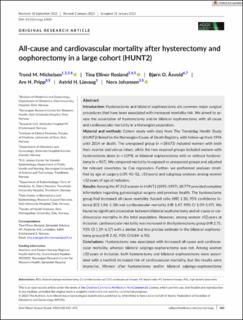| dc.description.abstract | Introduction
Hysterectomy and bilateral oophorectomy are common major surgical procedures that have been associated with increased mortality risk. We aimed to assess the association of hysterectomy and/or bilateral oophorectomy with all-cause and cardiovascular mortality in a Norwegian population.
Material and methods
Cohort study with data from The Trøndelag Health Study (HUNT2) linked to the Norwegian Cause of Death Registry, with follow-up from 1996 until 2014 or death. The unexposed group (n = 18 673) included women with both their ovaries and uterus intact, while the two exposed groups included women with hysterectomy alone (n = 1199), or bilateral oophorectomy with or without hysterectomy (n = 907). We compared mortality in exposed vs unexposed groups and adjusted for relevant covariates by Cox regression. Further, we performed analyses stratified by age at surgery (≤39, 40–52, ≥53 years) and subgroup analyses among women ≤52 years of age at inclusion.
Results
Among the 47 312 women in HUNT2 (1995–1997), 20 779 provided complete information regarding gynecological surgery and previous health. The hysterectomy group had increased all-cause mortality (hazard ratio [HR] 1.30, 95% confidence interval [CI] 1.06–1.58) and cardiovascular mortality (HR 1.47, 95% CI 1.09–1.97). We found no significant association between bilateral oophorectomy and all-cause or cardiovascular mortality in the total population. However, among women ≤52 years at inclusion, cardiovascular mortality was increased in the hysterectomy group (HR 2.71, 95% CI 1.19–6.17) with a similar, but less precise estimate in the bilateral oophorectomy group (HR 2.42, 95% CI 0.84–6.93).
Conclusions
Hysterectomy was associated with increased all-cause and cardiovascular mortality, whereas bilateral salpingo-oophorectomy was not. Among women ≤52 years at inclusion, both hysterectomy and bilateral oophorectomy were associated with a twofold increased risk of cardiovascular mortality, but the results were imprecise. Women after hysterectomy and/or bilateral salpingo-oophorectomy constitute a group with increased cardiovascular mortality that may need closer attention to cardiovascular disease risk from the healthcare system to ensure timely and effective preventive interventions. | en_US |

